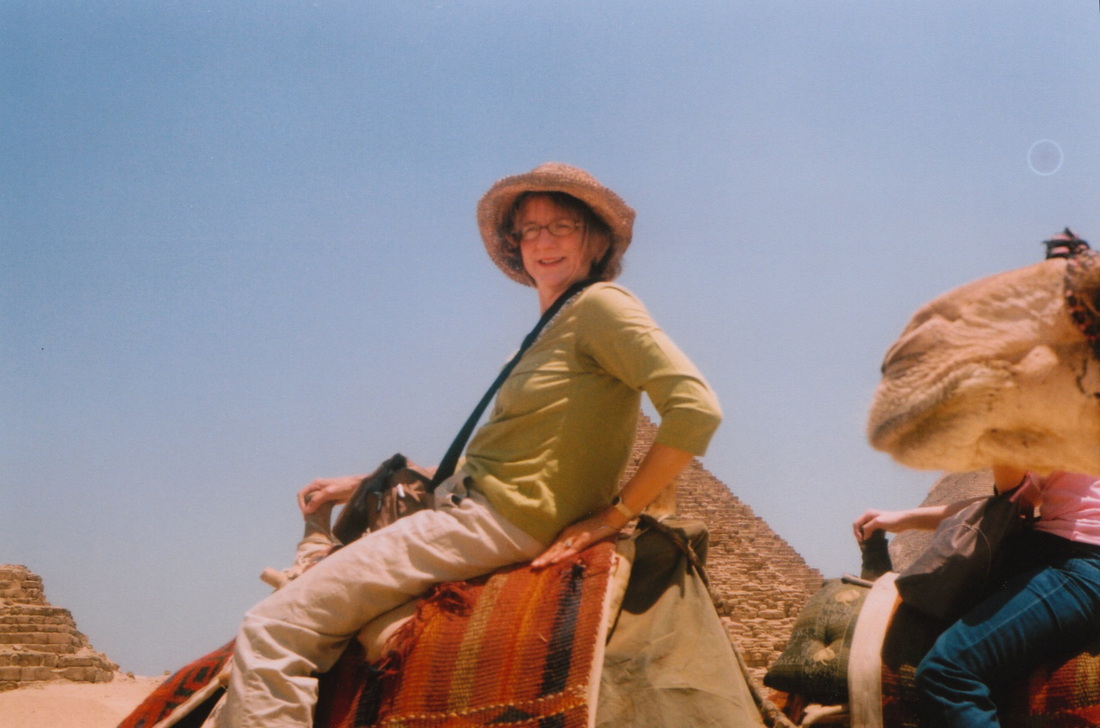To be able to stand before them and the grand Sphinx
is an experience of a lifetime.
The first glimpse I ever had of the Great Pyramids was an aerial view as we flew over the continent of Africa years ago en-route to the Seychelles Islands (another remarkable experience). The pilot had made an announcement and tipped his wings for a clear view. Their height and grandeur were great then but standing before them I was in awe.
One can explore the Pyramids in a myriad of ways. Of course, our little group decided to take the daring route.
Heck, if you’re going to have a “once in a lifetime experience,” make it count! We opted for a long camel ride around the massive site. The Pyramids sit in a “sandbox” in the center if Cairo in the suburb of Giza, on the Giza Plateau, and it’s as arid as any desert. Temps this time of year range from 98 - 120-degrees Farenheit. It was truly a nomadic experience.
I’m a control freak and riding horses intimidates me. I have the feeling that the animal is in control and has the last word and I don’t. Getting on a huge camel freaked me out. To say I was petrified was an understatement. Getting on a camel, even when it’s lounging on all fours, takes help. These are huge beasts. Once aboard, you grab the tiny wood knob on the carpeted “saddle” and hang on for dear life.
You have to hang on because the camel lurches forward as he stands upright. When upright you realize how tall these animals are. They also have an unusual gait. Instead of alternating hooves when walking, they use a front leg followed by a back leg on the same side of the body. The effect is a rolling motion as they amble on. It’s a bit disconcerting at first. You have to adjust yourself in your seat to stay stable. The rolling motion is actually the same undulation we dancers use in the “camel walk,” rather appropriate. When they walk on the sand the movement is more pronounced. It takes getting used to. Also, I encountered a new scent, “Eu de Camel.”
I did get a bit more comfortable as we trod up and down the sand dunes approaching the pyramids from the back, the area where there are few tourists. This area gives one the feel of the early explorers before there were tour buses and hoards of vacationers. The quiet is what I found astounding.
What a wonderful introduction to these massive structures.
The tranquility belies their original purpose as tombs for Khafre, Menkaure and Khufu (also known as the Great Pyramid, the largest).
We disembarked from the camels and walked around these massive structures. The perfection of their engineering and construction is confounding, considering the ancients had only rudimentary tools at their disposal. The building blocks are perfectly shaped and the fit so precise that a sheet of paper could not be slipped in between them. Their size is extraordinary.
The Sphinx stands as a sentinel in front of the pyramids like a guard dog on the watch. Actually in Arabic it is known as
“Abu al-Hol, “the father of terror.” If you’re wondering why he’s missing his nose, it was lost from deterioration before the 15th Century and not shot off by Napoleon as often written.
Unfortunately, especially as you travel to the front of the structures where most tourists gather and where the famous Sphinx is perched, beggars and hawkers abound. Everyone from camel drivers to people posing for pictures seek handouts. So many people are so desperately poor they rely on tourist money for survival.
Tipping, even for doing nothing, “baksheesh,” abounds throughout the country. It’s an annoyance but something you learn to deal with. The tips are so low they don’t hurt the pocketbook. Our exchange rate was five Egyptian Pounds for every one U.S. Dollar. Considering the average Egyptian earns the equivalent of two-dollars a day, go figure. Nonetheless, the one Arabic word I learned was, “laa shokran” (“no, thank you”) or “laa” for short. It helped to keep the persistent hawkers, selling things I absolutely didn’t want or need, at bay.
I've been told that the beggars are now banned from the historic site. Though an annoyance, I wonder how these people are faring without their only source of income. As Americans, we are wealthier that 75% of the world's population and it's a fact that we should note.

 RSS Feed
RSS Feed